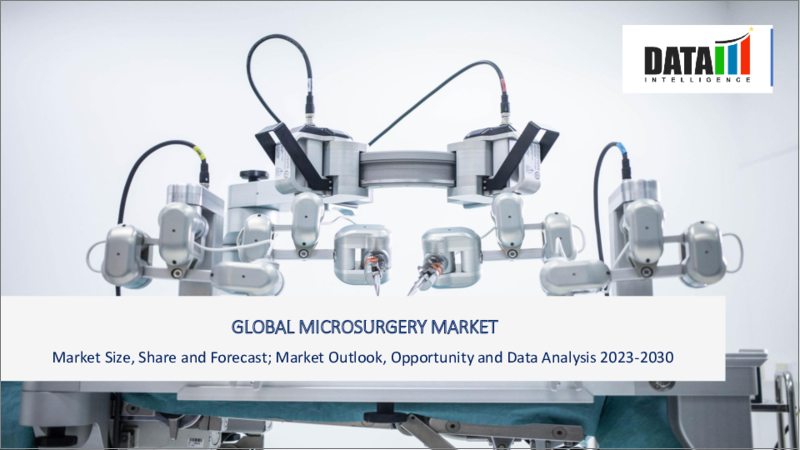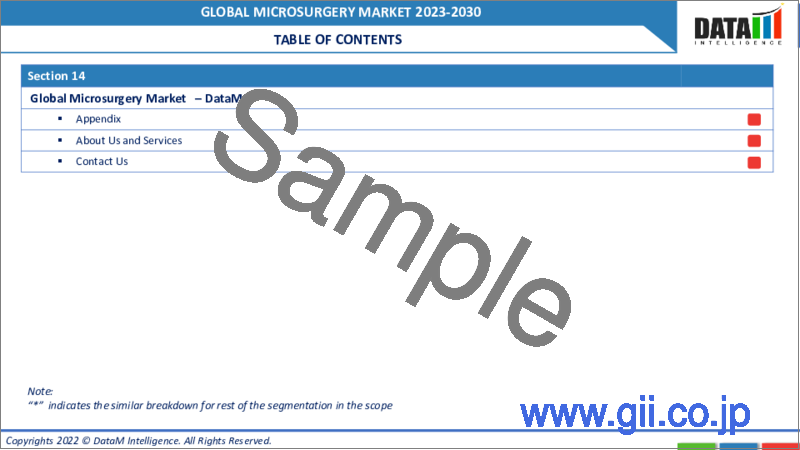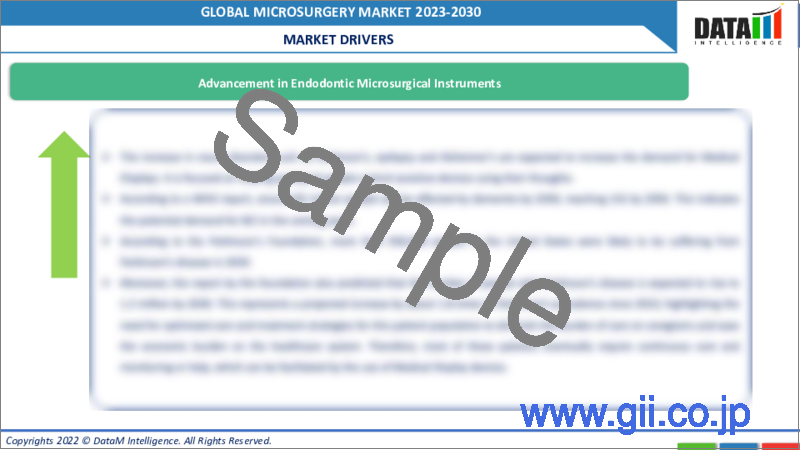|
|
市場調査レポート
商品コード
1129268
マイクロサージェリーの世界市場-2022-2029Global Microsurgery Market - 2022-2029 |
||||||
|
● お客様のご希望に応じて、既存データの加工や未掲載情報(例:国別セグメント)の追加などの対応が可能です。 詳細はお問い合わせください。 |
|||||||
| マイクロサージェリーの世界市場-2022-2029 |
|
出版日: 2022年09月29日
発行: DataM Intelligence
ページ情報: 英文 180 Pages
納期: 約2営業日
|
- 全表示
- 概要
- 目次
市場力学
歯内療法用マイクロサージェリー機器の進化が市場成長を牽引すると予想されます。
歯内療法手術は、不適切な器具や視認性の悪い手術部位、術後合併症のリスクが高いことから、最後の手段として位置づけられていました。しかし、照明、拡大、装置、材料の進歩により、歯内療法手術は歯内療法マイクロサージェリーに発展しました。高倍率化と小型化により、歯内療法手術の臨床成績は向上しています。従来の歯内療法用手術器具は、マイクロサージェリーの小さな骨切り部位にはかさばりすぎます。マイクロサージェリーで使用される器具の中には、従来の器具をミニチュア化したものはほとんどありません。マイクロインスツルメントを用いる歯内療法マイクロサージェリーは、侵襲の少ない治療法であり、予知性の高い結果を得ることができます。マイクロサージェリーは、約93.5%という高い成功率を誇り、外科的根管治療が不可能な場合に、歯根周囲の病変を管理するための信頼できる代替手段となります。従来の歯内療法に見られた限界を克服するために考案された革新的なアプローチにより、臨床家は成功率を向上させてきました。また、マイクロインスツルメントやバイオミメティックマテリアルにより、良好な歯内治療成績が得られています。したがって、上記の記述から、市場は予測期間内に駆動することが期待されます。
抑制要因
手術費用の高さ、償還政策の欠如、熟練した医療従事者の不足、手術に伴う副作用などが、予測期間中に市場が阻害される要因の一部と考えられています。
産業分析
マイクロサージェリー市場は、サプライチェーン分析、償還シナリオ、価格分析など、様々な業界要因に基づいた市場の詳細な分析を提供します。
COVID-19の影響分析
COVID-19のパンデミックは、ヘルスケアシステムと市場に適度な影響を与えています。世界中の美容外科医の何人かは、ほとんどの国際科学協会が推奨するすべての美容外科治療の中止を自ら宣言し、ほとんどの個人クリニックに大きな経済的影響を及ぼしています。
選択的手術の中止は人々に多大な影響を与え、世界中のヘルスケアシステムに長期的かつ潜在的に悲惨な影響を与え、市場の収益成長を鈍化させました。しかし、パンデミックによる慢性疾患の症例増加は、マイクロサージェリー治療に対する需要を高めました。さらに、パンデミックはサプライチェーンとプロセスを中断させます。多くの企業は、製品が利用可能な状態を維持し、サプライチェーンを保護するために、他の地域へと変化します。したがって、上記のステートメントから、市場は影響を受けたし、それは経済活動の再開とすぐにトラクションを得るために期待されます。
世界マイクロサージェリー市場レポートでは、約45+市場データテーブル、40+図と180ページへのアクセスを提供します。
目次
第1章 調査手法と調査範囲
- 調査手法
- 調査目的および調査範囲
第2章 市場の定義と概要
第3章 エグゼクティブサマリー
第4章 市場の力学
- 市場影響要因
- 促進要因
- 歯内療法用マイクロサージェリー機器の進歩が市場成長を牽引すると予想される。
- 抑制要因
- 手術費用の高さが市場成長を阻害すると予想されます。
- 機会
- 影響分析
- 促進要因
第5章 産業分析
- サプライチェーン分析
- 価格設定分析
- アンメットニーズ分析
- パイプライン分析
第6章 COVID-19の分析
- COVID-19の市場分析
- COVID-19以前の市場シナリオ
- COVID-19の現在の市場シナリオ
- COVID-19の後、または将来のシナリオ
- COVID-19の中での価格ダイナミクス
- 需要-供給スペクトラム
- パンデミック時の市場に関連する政府の取り組み
- メーカーの戦略的な取り組み
- まとめ
第7章 処置別
- 縫合と移植
- フリーフラップ・ティッシュトランスファー
- 創傷再建
- 移植術
- 神経修復
- その他
第8章 アプリケーション別
- 一般外科
- 腫瘍学
- 神経内科
- 眼科
- 整形外科
- 形成外科
- 婦人科手術
- その他
第9章 機器別
- 手術用顕微鏡
- マイクロサージェリー鉗子・ニードルホルダー
- マイクロ縫合糸
- その他
第10章 エンドユーザー別
- 病院
- 外来手術センター
- 研究機関
- その他
第11章 地域別
- 北米
- 米国
- カナダ
- メキシコ
- 欧州
- ドイツ
- 英国
- フランス
- イタリア
- スペイン
- その他欧州
- 南米
- ブラジル
- アルゼンチン
- その他の南米地域
- アジア太平洋地域
- 中国
- インド
- 日本
- オーストラリア
- その他アジア太平洋地域
- 中東・アフリカ地域
第12章 競合情勢
- 主な展開と戦略
- 企業シェア分析
- 製品ベンチマーク
- 注目の主要企業リスト
第13章 企業プロファイル
- ZEISS International
- 企業概要
- 製品ポートフォリオと説明
- 主なハイライト
- 財務概要
- Hu-Friedy Mfg. Co., LLC
- MicroSurgical Technology
- Aesculap, Inc.
- Peter Lazic Gmbh
- Synovis Life Technologies, Inc.
- Aros Surgical
- Medline Industries, LP
- Aurolab
- Beaver-Visitec International
第14章 マイクロサージェリーの世界市場-DataM
Market Overview
Microsurgery Market size was valued US$ YY million in 2021 and is estimated to reach US$ YY million by 2029, growing at a CAGR of 6.9 % during the forecast period (2022-2029).
Microsurgery is a cutting-edge surgical technique that allows for a minimally invasive operation. High-powered microscopes are used in this surgery to observe what is beneath the skin without normal cutting the body. Miniaturized tools and a microscope are instead inserted through small incisions. Microsurgery is a delicate and small construction of blood vessels, tubes, and nerves, typically 1 mm or less in diameter. Because of their function restoration and post-trauma healing capabilities, microsurgeries are extensively used in skin grafting, congenital deficits, and cancer treatment.
Market Dynamics
Advancement in Endodontic Microsurgical Instruments is expected to drive the market growth.
Endodontic surgery was viewed as a last resort due to inappropriate equipment, surgical areas with poor visibility, and an elevated risk of postoperative complications. However, with advancements in illumination, magnification, equipment, and materials, endodontic surgery has evolved into endodontic microsurgery. Higher magnification and tiny tools have improved the clinical outcome of endodontic surgery. Traditional endodontic surgical instruments are too bulky for the small osteotomy sites of microsurgery. Few of the devices used in microsurgery are miniature versions of traditional instruments. Endodontic microsurgery, which employs micro-instruments, is a less invasive treatment approach with predictable outcomes. Microsurgery has a high success record of about 93.5 percent, giving it a dependable alternative for managing periapical pathology when surgical root treatment is not possible. Clinicians have achieved improved success rates thanks to innovative approaches designed to overcome the limitations observed in traditional endodontic surgery. Along with micro-instruments, biomimetic materials have resulted in favorable endodontic surgery outcomes. Thus, from the above statements, the market is expected to drive in the forecast period.
Restraint:
High costs of the surgeries, lack of reimbursement policies, lack of skilled healthcare professionals and side effects associated with the surgeries are some of the factors the market is expected to get hampered in the forecast period.
Industry Analysis
The microsurgery market provides in-depth analysis of the market based on various industry factors such as supply chain analysis, reimbursement scenario, pricing analysis etc.
COVID-19 Impact Analysis
The COVID-19 pandemic has moderately impacted healthcare systems and the market. Several surgeons worldwide in the field of cosmetic surgery have self-imposed a suspension of all aesthetic surgery treatments advised by most international scientific associations, which has had a significant economic impact on most private clinics.
Canceling elective surgeries had a tremendous impact on people and had long-term, potentially disastrous effects on healthcare systems worldwide, slowing market revenue growth. However, the pandemic's increasing cases of chronic diseases raised the demand for microsurgery treatments. Additionally, the pandemic interrupts the supply chain and process. Many companies will vary to other geographic regions to ensure that products remain available and protect their supply chain. Thus, from the above statements, the market got affected, and it is expected to gain traction quickly with the resumption of economic activities.
Segment Analysis
Free Flap Tissue Transfer segment is expected to hold the largest market share in microsurgery market
The free flap tissue transfer segment is expected to dominate in 2021. The segment benefits because free flap surgery, also known as free tissue transfer, is a reconstructive surgical method involving transferring skin or tissue from one section of the body to another. At the same time, a major vein or artery remains linked to the tissue being transplanted. The perfusion and drainage of the flap and its survival are ensured in the latter stages of this procedure. The ability to transfer living tissue from one body part to another has greatly simplified complex defect reconstruction. This method has several advantages, including stable wound covering, improved functional and aesthetic outcomes, less donor site morbidity, and the ability to use vascularized tissue from remote body parts outside the region of damage. Microsurgical free flap reconstruction employs a variety of surgical flaps to meet the needs of the recipient site. The options include cutaneous, bone, muscular, or a combination. Therefore, it has increased the demand for the procedure. Thus, from the above statements, the market segment is expected to hold the largest market share in the forecast period.
Geographical Analysis
North America region holds the largest market share in the global microsurgery market
In 2021, North America accounted for the highest revenue share. The increasing prevalence of cancer and neurological disorders, adoption of highly advanced microsurgical equipment, well-established infrastructure, and product launches by the key market players are some factors the market is expected to boost in the forecast period. For instance, In the United States in 2019, 1,752,735 new cancer cases were reported and 599,589 cancer deaths. 439 new cancer cases were reported for every 100,000 people, and 146 individuals died from cancer. In Contrast, 1.9 million new cancer cases will be diagnosed in the United States in 2021, with 608,570 cancer fatalities. Therefore, it has increased the demand for microsurgery.
Moreover, on May 26, 2022, micro medical instruments, a robotics firm dedicated to producing clinical experiences for microsurgery patients, unveiled a new simulator dubbed symani surgical system simulator for microsurgery. The advanced system is designed to help doctors perform better procedures. Thus, from the above statements, the North American region is expected to hold the largest market share in the forecast period.
Competitive Landscape
Major key players in the microsurgery market are ZEISS International, Hu-Friedy Mfg. Co., LLC, MicroSurgical Technology, Aesculap, Inc., Peter Lazic Gmbh, Synovis Life Technologies, Inc., Aros Surgical, Medline Industries, LP, Aurolab , Beaver-Visitec International .
Aurolab:
Overview:
Aurolab, based in southern India, is an integral part of the Aravind Eye Care System. The company manufactures a wide range of high-quality ophthalmic consumables such as Intraocular Lenses, Surgical sutures, Pharmaceutical products, surgical blades and types of equipment. Though its primary focus is on the ophthalmic segment, the company's diversifying into related health care areas where its capabilities are leveraged, such as cardiovascular sutures, microsurgical hand sutures, antiseptics, disinfectant solutions, spectacle cleaner etc. All the company products are manufactured on efficient production lines with strict quality assurance measures that comply with US FDA, EU GMP, and WHO GMP norms. Aurolab products are exported to 130 countries worldwide, focusing on markets like India, Africa, Latin America, Central America and Southeast Asia.
Product Portfolio:
Black Monofilament Nylon Micro sutures: These sutures are utilized in microsurgeries such as hand nerve operations, plastic surgeries, and skin surgeries and feature an improved micro taper for minimal penetration force, a specific suture needle attachment procedure for optimum strength, and goods that are completely biocompatible.
The global microsurgery market report would provide an access to an approx. 45+market data table, 40+figures and 180pages.
Table of Contents
1. Methodology and Scope
- 1.1. Research Methodology
- 1.2. Research Objective and Scope of the Report
2. Market Definition and Overview
3. Executive Summary
4. Market Dynamics
- 4.1. Market Impacting Factors
- 4.1.1. Drivers
- 4.1.1.1. Advancement in Endodontic Microsurgical Instruments is expected to drive the market growth.
- 4.1.2. Restraints:
- 4.1.2.1. High costs of the surgeries are expected to hamper the market growth.
- 4.1.3. Opportunity
- 4.1.4. Impact Analysis
- 4.1.1. Drivers
5. Industry Analysis
- 5.1. Supply Chain Analysis
- 5.2. Pricing Analysis
- 5.3. Unmet Needs
- 5.4. Pipeline Analysis
6. COVID-19 Analysis
- 6.1. Analysis of Covid-19 on the Market
- 6.1.1. Before COVID-19 Market Scenario
- 6.1.2. Present COVID-19 Market Scenario
- 6.1.3. After COVID-19 or Future Scenario
- 6.2. Pricing Dynamics Amid Covid-19
- 6.3. Demand-Supply Spectrum
- 6.4. Government Initiatives Related to the Market During Pandemic
- 6.5. Manufacturers Strategic Initiatives
- 6.6. Conclusion
7. By Procedure
- 7.1. Introduction
- 7.1.1. Market Size Analysis, and Y-o-Y Growth Analysis (%), By Procedure
- 7.1.2. Market Attractiveness Index, By Procedure Segment
- 7.2. Suture and Grafting*
- 7.2.1. Introduction
- 7.2.2. Market Size Analysis, US$ Million, 2020-2029 and Y-o-Y Growth Analysis (%), 2021-2029
- 7.3. Free Flap Tissue Transfer
- 7.4. Wound Reconstruction
- 7.5. Transplantation
- 7.6. Nerve Repair
- 7.7. Others
8. By Application
- 8.1. Introduction
- 8.1.1. Market Size Analysis, and Y-o-Y Growth Analysis (%), By Application
- 8.1.2. Market Attractiveness Index, By Application Segment
- 8.2. General Surgery*
- 8.2.1. Introduction
- 8.2.2. Market Size Analysis, US$ Million, 2020-2029 and Y-o-Y Growth Analysis (%), 2021-2029
- 8.3. Oncology
- 8.4. Neurology
- 8.5. Ophthalmology
- 8.6. Orthopedic Surgery
- 8.7. Plastic & Reconstructive Surgery
- 8.8. Gynecology Surgery
- 8.9. Others
9. By Equipment
- 9.1. Introduction
- 9.1.1. Market Size Analysis, and Y-o-Y Growth Analysis (%), By Equipment
- 9.1.2. Market Attractiveness Index, By Equipment Segment
- 9.2. Operating Microscopes*
- 9.2.1. Introduction
- 9.2.2. Market Size Analysis, US$ Million, 2020-2029 and Y-o-Y Growth Analysis (%), 2021-2029
- 9.3. Microsurgery Forceps & Needle Holders
- 9.4. Microsutures
- 9.5. Others
10. By End user
- 10.1. Introduction
- 10.1.1. Market Size Analysis, and Y-o-Y Growth Analysis (%), By End user
- 10.1.2. Market Attractiveness Index, By End user Segment
- 10.2. Hospitals*
- 10.2.1. Introduction
- 10.2.2. Market Size Analysis, US$ Million, 2020-2029 and Y-o-Y Growth Analysis (%), 2021-2029
- 10.3. Ambulatory Surgery Centers
- 10.4. Research Organization
- 10.5. Others
11. By Region
- 11.1. Introduction
- 11.1.1. Market Size Analysis, US$ Million, 2020-2029 and Y-o-Y Growth Analysis (%), 2021-2029, By Region
- 11.1.2. Market Attractiveness Index, By Region
- 11.2. North America
- 11.2.1. Introduction
- 11.2.2. Key Region-Specific Dynamics
- 11.2.3. Market Size Analysis, and Y-o-Y Growth Analysis (%), By Procedure
- 11.2.4. Market Size Analysis, and Y-o-Y Growth Analysis (%), By Application
- 11.2.5. Market Size Analysis, and Y-o-Y Growth Analysis (%), By Equipment
- 11.2.6. Market Size Analysis, and Y-o-Y Growth Analysis (%), By End user
- 11.2.7. Market Size Analysis, and Y-o-Y Growth Analysis (%), By Country
- 11.2.7.1. U.S.
- 11.2.7.2. Canada
- 11.2.7.3. Mexico
- 11.3. Europe
- 11.3.1. Introduction
- 11.3.2. Key Region-Specific Dynamics
- 11.3.3. Market Size Analysis, and Y-o-Y Growth Analysis (%), By Procedure
- 11.3.4. Market Size Analysis, and Y-o-Y Growth Analysis (%), By Application
- 11.3.5. Market Size Analysis, and Y-o-Y Growth Analysis (%), By Equipment
- 11.3.6. Market Size Analysis, and Y-o-Y Growth Analysis (%), By End user
- 11.3.7. Market Size Analysis, and Y-o-Y Growth Analysis (%), By Country
- 11.3.7.1. Germany
- 11.3.7.2. U.K.
- 11.3.7.3. France
- 11.3.7.4. Italy
- 11.3.7.5. Spain
- 11.3.7.6. Rest of Europe
- 11.4. South America
- 11.4.1. Introduction
- 11.4.2. Key Region-Specific Dynamics
- 11.4.3. Market Size Analysis, and Y-o-Y Growth Analysis (%), By Procedure
- 11.4.4. Market Size Analysis, and Y-o-Y Growth Analysis (%), By Application
- 11.4.5. Market Size Analysis, and Y-o-Y Growth Analysis (%), By Equipment
- 11.4.6. Market Size Analysis, and Y-o-Y Growth Analysis (%), By End user
- 11.4.7. Market Size Analysis, and Y-o-Y Growth Analysis (%), By Country
- 11.4.7.1. Brazil
- 11.4.7.2. Argentina
- 11.4.7.3. Rest of South America
- 11.5. Asia Pacific
- 11.5.1. Introduction
- 11.5.2. Key Region-Specific Dynamics
- 11.5.3. Market Size Analysis, and Y-o-Y Growth Analysis (%), By Procedure
- 11.5.4. Market Size Analysis, and Y-o-Y Growth Analysis (%), By Application
- 11.5.5. Market Size Analysis, and Y-o-Y Growth Analysis (%), By Equipment
- 11.5.6. Market Size Analysis, and Y-o-Y Growth Analysis (%), By End user
- 11.5.7. Market Size Analysis, and Y-o-Y Growth Analysis (%), By Country
- 11.5.7.1. China
- 11.5.7.2. India
- 11.5.7.3. Japan
- 11.5.7.4. Australia
- 11.5.7.5. Rest of Asia Pacific
- 11.6. Middle East and Africa
- 11.6.1. Introduction
- 11.6.2. Key Region-Specific Dynamics
- 11.6.3. Market Size Analysis, and Y-o-Y Growth Analysis (%), By Procedure
- 11.6.4. Market Size Analysis, and Y-o-Y Growth Analysis (%), By Application
- 11.6.5. Market Size Analysis, and Y-o-Y Growth Analysis (%), By Equipment
- 11.6.6. Market Size Analysis, and Y-o-Y Growth Analysis (%), By End user
12. Competitive Landscape
- 12.1. Key Developments and Strategies
- 12.2. Company Share Analysis
- 12.3. Product Benchmarking
- 12.4. List of Key Companies to Watch
13. Company Profiles
- 13.1. ZEISS International*
- 13.1.1. Company Overview
- 13.1.2. Product Portfolio and Description
- 13.1.3. Key Highlights
- 13.1.4. Financial Overview
- 13.2. Hu-Friedy Mfg. Co., LLC
- 13.3. MicroSurgical Technology
- 13.4. Aesculap, Inc.
- 13.5. Peter Lazic Gmbh
- 13.6. Synovis Life Technologies, Inc.
- 13.7. Aros Surgical
- 13.8. Medline Industries, LP
- 13.9. Aurolab
- 13.10. Beaver-Visitec International
LIST NOT EXHAUSTIVE
14. Global Microsurgery Market - DataM
- 14.1. Appendix
- 14.2. About Us and Applications
- 14.3. Contact Us




